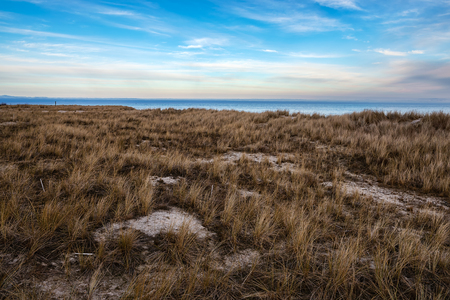Introduction to Lindisfarne and Its Tidal Wonders
Nestled off the rugged Northumberland coast, the Holy Island of Lindisfarne is a true British treasure, steeped in history and natural beauty. Renowned for its enchanting tidal causeway, which appears and disappears with the rhythm of the North Sea, Lindisfarne offers visitors a unique adventure that blends tranquillity, heritage, and a touch of magic. Crossing the tidal paths isn’t just a practical way to reach the island—it’s a memorable experience in itself, as walkers and families alike time their journeys to follow in the footsteps of saints, monks, and adventurers from centuries past. The landscape transforms dramatically with each tide, revealing vast mudflats scattered with seabirds and wildflowers when the waters recede. Walking here is more than just a ramble; it’s an invitation to slow down and savour a truly iconic slice of Northumberland life, where every step tells a story and every view whispers echoes of ancient times.
2. Preparing for the Crossing: Tide Times and Safety
Before setting out to walk the tidal paths to Lindisfarne, it’s absolutely crucial to understand how important tide timings are for a safe journey. The Holy Island causeway is only accessible at certain times of the day, as twice daily the North Sea tides flood the road and footpath, making them impassable. To ensure a smooth and enjoyable adventure, especially for families or those new to the area, a little planning goes a long way.
Checking Tide Timetables
The first step is to consult the official tide tables, which can be found on local council websites or notice boards near the crossing point. It’s best to plan your walk so that you set off as soon as it’s safe to cross after the tide has receded. This gives you ample time to enjoy exploring the island without worrying about being caught by incoming water.
| Step | Details |
|---|---|
| 1. Check Tide Times | Visit Northumberland County Council website or local notice boards for up-to-date crossing times. |
| 2. Plan Your Crossing Window | Aim to start as soon as the causeway opens and finish well before the next high tide. |
| 3. Allow Extra Time | Add an hour buffer on each side of official safe times—especially with children or slower walkers. |
Staying Safe During Tidal Crossings
Safety should always come first when walking across to Lindisfarne. The tides here move swiftly and unpredictably, so never attempt to cross outside of the published safe times. There are refuge huts along the route in case of emergencies, but these should not be relied upon except in genuine distress.
- Do not rush: Take your time and watch your footing, especially if walking with children.
- Stick to marked paths: Follow posts and signs marking safe routes – venturing off can be dangerous due to mudflats and quicksand.
- No shortcuts: Stay together as a group; don’t try to beat the tide by hurrying across unsafe areas.
- Prepare for weather: Bring waterproofs and windbreakers, as conditions can change quickly by the sea.
Local Advice for First-Time Visitors
If you’re unfamiliar with tidal crossings or visiting Lindisfarne for the first time, friendly locals and visitor centre staff are always happy to offer advice. Don’t hesitate to ask about recent weather patterns or any changes in usual crossing routines—local knowledge can make all the difference.
Top Tips for Families & New Walkers
- Keep an eye on young children—hold hands where necessary near waterlogged spots.
- Pack snacks and water—there are limited facilities until you reach the village.
- If in doubt, wait it out: If unsure about timing or conditions, play it safe and wait for clear advice before crossing.
By taking these simple but essential precautions, you’ll help ensure your journey across Lindisfarne’s iconic tidal paths is both safe and unforgettable for everyone in your group.

3. Top Trails on Holy Island
If you’re eager to lace up your boots and explore Lindisfarne, you’re in for a treat. The Holy Island boasts a delightful mix of walking trails, perfect for families and walkers of all abilities. Whether you fancy coastal views, wildlife spotting, or immersing yourself in history, there’s a route that will charm you.
The Pilgrim’s Way
This ancient path is perhaps the most iconic route to Holy Island. Marked by tall wooden poles across the tidal sands, the Pilgrim’s Way follows the footsteps of countless travellers over centuries. It’s best walked at low tide—always check tide times! The experience is truly special as you cross open sands with panoramic views of the North Sea and distant castle turrets beckoning ahead.
Lindisfarne Castle Trail
This popular circular walk starts from the village and winds its way along the coast before climbing gently to Lindisfarne Castle. En route, you’ll pass wildflower meadows and salt marshes buzzing with birdlife. Take your time exploring the castle itself, perched dramatically atop its rocky outcrop—a must-see for visitors of all ages.
Priory & Village Walk
For those keen on a gentler stroll with plenty of history, follow this relaxed loop around Lindisfarne village. You’ll discover the hauntingly beautiful ruins of Lindisfarne Priory—once home to medieval monks—and enjoy pottering down charming lanes dotted with traditional stone cottages, local shops, and cosy tea rooms.
Nature Reserve Paths
If wildlife and peaceful scenery are more your cup of tea, venture into the Lindisfarne National Nature Reserve. Boardwalks and grassy trails take you through dunes and wetlands alive with migratory birds and colourful wildflowers. These quieter paths are ideal for families hoping to spot seals basking on distant sandbanks or simply enjoy a picnic surrounded by natural beauty.
Each trail offers its own slice of island magic—whether it’s sweeping sea vistas or echoes of history beneath your feet. With so much variety packed into this tiny isle, every step brings a new discovery on Holy Island.
4. Spotting Wildlife and Embracing Nature
One of the true joys of hiking the Holy Island’s trails is the chance to immerse yourself in Lindisfarne’s remarkable natural beauty. For families and keen ramblers alike, there’s much more to explore than just the historical sites—the island’s unique wildlife and habitats promise memorable moments for all ages.
Birdwatching Tips for Families
Lindisfarne is a haven for bird enthusiasts, boasting an array of resident and migratory species. Don’t forget your binoculars! The mudflats and salt marshes are alive with waders such as curlews, redshanks, and oystercatchers. Winter months bring thousands of wildfowl, while summer welcomes terns and warblers. Early morning or late afternoon walks offer the best chances to spot these feathered visitors without crowds.
Popular Birds on Lindisfarne
| Bird Species | Best Season to Spot | Where to Look |
|---|---|---|
| Curlew | Autumn & Winter | Mudflats, Salt Marshes |
| Brent Goose | Winter | Tidal Flats |
| Little Tern | Summer | Nesting Beaches |
| Peregrine Falcon | Year-round | Dunes & Cliffs |
Exploring Salt Marshes: A Family Adventure
The salt marshes of Lindisfarne are not only scenic but also bustling with life. These marshlands are easy to explore via marked footpaths—perfect for little explorers with wellies in tow! Look out for colourful wildflowers in spring and listen for the call of skylarks overhead. Remember to stick to the paths to protect delicate plants and nesting grounds.
Seal Spotting Along the Shoreline
No family trip to Lindisfarne is complete without searching for the playful grey seals basking on sandbanks or popping up from the waves. Bring a pair of binoculars and scan the tideline at low tide; common viewing spots include Snook Point and Harbour Beach. Remind children to keep a respectful distance—these gentle creatures are best admired quietly from afar.
Family-Friendly Nature Checklist:
- Packed picnic & reusable water bottles
- Binoculars for spotting birds and seals
- Waterproof boots or wellies for marsh walks
- A pocket guidebook or spotter sheet for local wildlife
- A camera or sketchbook to capture special finds
Embracing nature on Lindisfarne brings families together, encourages curiosity, and creates lasting memories amid one of Britain’s most breathtaking coastal landscapes.
5. Family-Friendly Stops and Local Treats
Exploring Lindisfarne’s tidal trails is a memorable adventure for families, and there are plenty of spots that make it easy to pause, refuel, and simply enjoy the island’s charms together. Whether you’re after the perfect picnic perch or a sweet treat to round off your walk, Holy Island has something for everyone.
Perfect Picnic Spots for All Ages
Pack up your favourite sandwiches and snacks before crossing the causeway, as there are some cracking places to lay down a blanket. The grounds near Lindisfarne Priory offer an atmospheric backdrop for a family lunch, with plenty of space for little ones to stretch their legs. Alternatively, the grassy dunes by St Cuthbert’s Island provide sweeping sea views—ideal for a peaceful bite surrounded by nature.
Cosy Tearooms and Welcoming Cafés
If you prefer to let someone else do the baking, Holy Island’s tearooms are a real treat. Head to Pilgrims Coffee House for locally roasted brews and homemade cakes; their scones are especially popular with young explorers. For something heartier, The Crown and Anchor serves up classic British fare in a friendly setting—perfect for warming up after a breezy walk.
Lindisfarne Mead: A Local Favourite
No visit would be complete without sampling Lindisfarne Mead. While this honey wine is strictly for grown-ups, older children will enjoy hearing about its medieval history at St Aidan’s Winery, where you’ll find gifts and non-alcoholic options too. The fudge shop on the high street is another must-visit spot—kids love watching the sweets being made and picking out their favourites to take home.
Helpful Amenities for Visiting Families
The island is well set up for visitors with children. There are public toilets near the main car park and at several attractions, plus baby-changing facilities in most cafés. Many sites have picnic benches and sheltered areas if the North Sea breeze picks up. Don’t forget to check tide times before setting out—safe crossings mean more time to explore these family-friendly gems!
6. Respecting Local Life and Treading Lightly
Lindisfarne is not just a place of natural beauty, but also a living community with deep-rooted traditions. As you hike the Holy Island trails, it’s important to respect both the tranquillity of the landscape and the daily life of islanders. Here are some thoughtful ways to ensure your visit is mindful and considerate.
Honouring Island Customs
The pace of life on Lindisfarne is gentle, and many residents cherish the peace that tides bring. When walking through the village or along the causeway, keep noise to a minimum, especially in early mornings or late evenings. If you pass locals, a friendly nod or a simple “Good morning” is always appreciated—it’s a small gesture that goes a long way in rural Northumberland.
Walking with Care
Stick to marked footpaths when exploring the island, as this helps protect sensitive habitats and avoids disturbing wildlife. Remember to close gates behind you and avoid venturing into private gardens or farmland—these are working spaces, not tourist attractions.
Supporting Local Businesses
If you’re stopping for a bite or picking up souvenirs, choose local cafés, craft shops, or markets. Not only will you find unique keepsakes and homemade treats, but your custom directly supports the island’s economy and its people.
Environmental Mindfulness
Carry away any litter, including biodegradable items like fruit peels, as they can harm local ecosystems. Use refillable water bottles to reduce single-use plastics and be aware of protected areas—many dunes and salt marshes are delicate habitats for rare birds and plants. Dogs should be kept on leads near wildlife or livestock, especially during nesting seasons.
A Thoughtful Departure
Before leaving Lindisfarne, take a moment to soak in its serenity—and leave it just as you found it. Your respectful presence ensures the Holy Island remains a treasured sanctuary for generations of visitors and locals alike.


